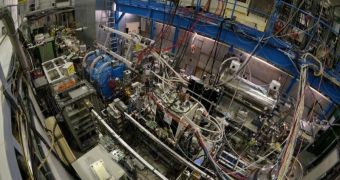Officials with the Atomic Spectroscopy And Collisions Using Slow Antiprotons (ASACUSA) experiment at the European Organization for Nuclear Research (CERN) announce the production of the first-ever antihydrogen beam at the world's largest particle accelerator.
Around 80 antihydrogen – a form of antimatter – atoms were detected in the ASACUSA experiment, roughly 2.7 meters (9 feet) from where they were synthesized, the team behind the study explain.
This complex experiment was first proposed back in 1997. Its goal is to study the hyperfine structure of antihydrogen through a technique called microwave spectroscopy. Additionally, the instrument can also use laser spectroscopy to analyze CPT symmetry, a fundamental symmetry of physical laws proposed by theoretical physicists .
Scientists operating ASACUSA have been trying to produce antimatter beams for quite some time now, so the announcement that 80 antihydrogen atoms have been discovered was received with excitement.
Details of the work appear in a paper entitled “A source of antihydrogen for in-flight hyperfine spectroscopy,” which was published in the January 21 issue of the journal Nature Communications.
The team explains that the reason why the antimatter atoms were discovered a short distance away from the place where they were first produced is that the magnetic fields used to synthesize this form of antimatter decreased in intensity, and created less perturbations, farther away from the source.
The ASACUSA research group argues that this breakthrough is a critically-important step forward in the effort to conduct precise hyperfine spectroscopy of antihydrogen atoms. These atoms were produced by combining positively-charged electrons, or positrons, with low-energy antiprotons synthesized in the Antiproton Decelerator experiment.
“Antihydrogen atoms having no charge, it was a big challenge to transport them from their trap. Our results are very promising for high-precision studies of antihydrogen atoms, particularly the hyperfine structure, one of the two best known spectroscopic properties of hydrogen,” says RIKEN investigator Yasunori Yamazaki.
“ts measurement in antihydrogen will allow the most sensitive test of matter/antimatter symmetry. We are looking forward to restarting this summer with an even more improved set-up,” concludes the expert, who is one of the leaders of the ASACUSA Collaboration.

 14 DAY TRIAL //
14 DAY TRIAL //